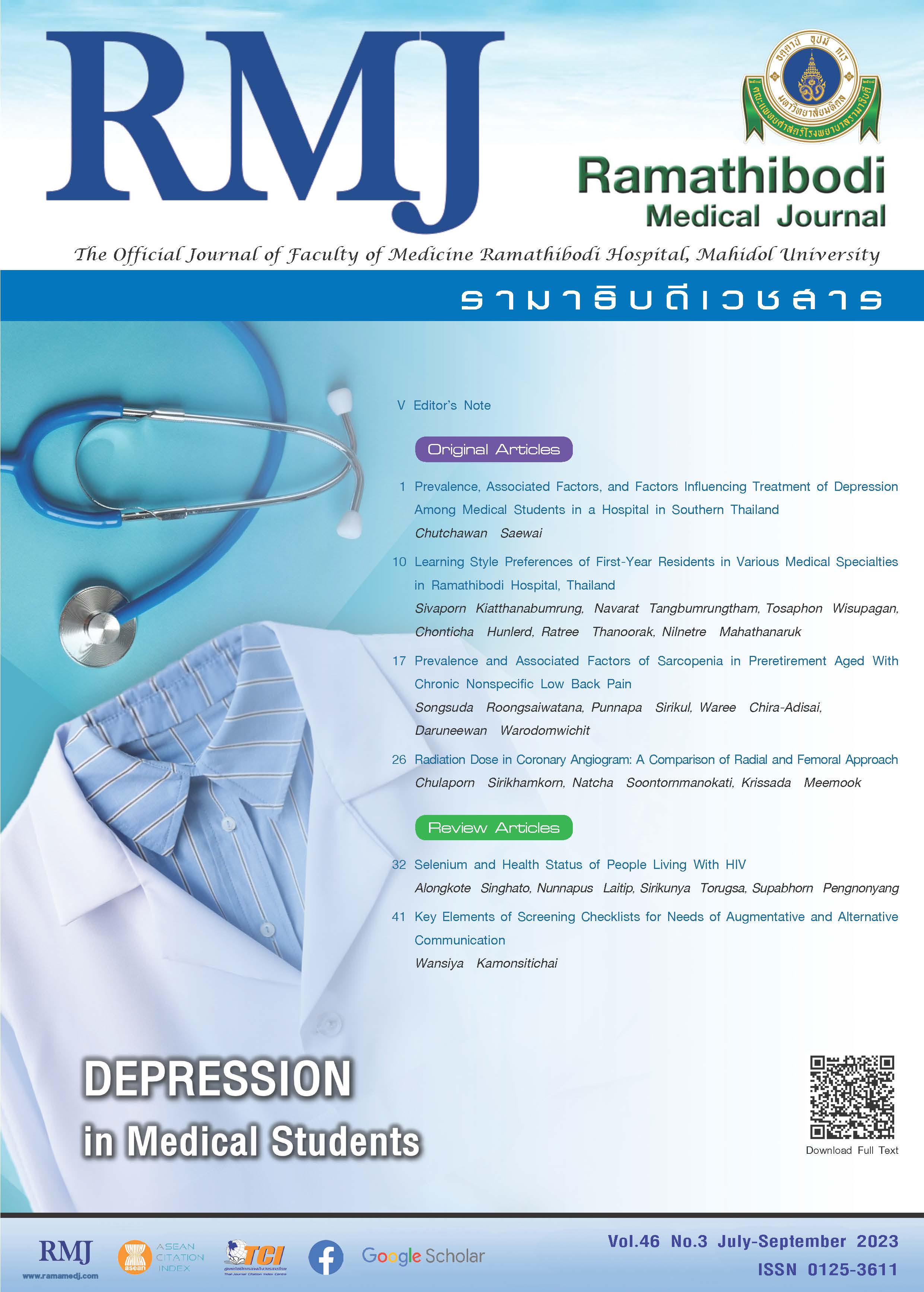Key Elements of Screening Checklists for Needs of Augmentative and Alternative Communication
DOI:
https://doi.org/10.33165/rmj.2023.46.3.263780Keywords:
Augmentative and alternative communication, Complex communication needs, Speech-language pathologists, Screening checklistAbstract
With the use of augmentative and alternative communication (AAC), people with complex communication needs could participate in social situations even if they had severe speech impairments. Even though speech-language therapists in Thailand are aware of AAC, they still mainly teach young children with complex communication needs to mainly use speech as a means to communicate. This could lead to fewer opportunities for people with complex communication needs to use AAC systems. Therefore, this article aimed to analyze and classify the items related to communication success, as a guideline to generate a screening checklist for determining whether individuals with a communication impairment would benefit from using AAC. Three previously available screening checklists pertaining to communication success were analyzed to identify the 3 domains: 1) verbal communication intelligibility, 2) verbal functional communication, and 3) verbal communication comprehension. These 3 domains were divided into 2 aspects: 1) familiar/unfamiliar communication partners, and 2) familiar/unfamiliar settings. To create a standard screening checklist that speech-language pathologists in Thailand could utilize, more research would need to be done in the future.
References
American Speech-Language-Hearing Association. Augmentative and Alternative Communication. Accessed June 22, 2023. https://www.asha.org/practice-portal/professional-issues/augmentative-and-alternative-communication/#collapse_1
Beukelman DR, Mirenda P. Augmentative and Alternative Communication: Supporting Children and Adults with Complex Communication Needs. 4th ed. Paul H. Brookes Publishing; 2013.
Doyle M, Phillips B. Trends in augmentative and alternative communication use by individuals with amyotrophic lateral sclerosis. Augment Altern Commun. 2001;17(3):167-178. doi:10.1080/aac.17.3.167.178
Light J. Interaction involving individuals using augmentative and alternative communication systems: state of the art and future directions. Augment Altern Commun. 1988;4(2):66-82. doi:10.1080/07434618812331274657
McNaughton D, Light J, Groszyk L. “Don’t give up”: employment experiences of individuals with amyotrophic lateral sclerosis who use augmentative and alternative communication. Augment Altern Commun. 2001;17(3):179-195. doi:10.1080/aac.17.3.179.195
Mathy P, Yorkston KM, Gutmann ML. AAC for individuals with amyotrophic lateral sclerosis. In: Beukelman DR, Yorkston KM, Reichle J, eds. Augmentative and Alternative Communication for Adults with Acquired Neurological Disorders. Paul H Brookes Publishing; 2000:183-232.
Murphy J. “I prefer contact this close”: perceptions of AAC by people with motor neurone disease and their communication partners. Augment Altern Commun. 2004;20(4):259-271. doi:10.1080/07434610400005663
Drager K, Light J, McNaughton D. Effects of AAC interventions on communication and language for young children with complex communication needs. J Pediatr Rehabil Med. 2010;3(4):303-310. doi:10.3233/PRM-2010-0141
Binger C, Kent-Walsh J, Berens J, Del Campo S, Rivera D. Teaching Latino parents to support the multi-symbol message productions of their children who require AAC. Augment Altern Commun. 2008;24(4):323-338. doi:10.1080/07434610802130978.
Binger C, Light J. Demographics of preschoolers who require AAC. Lang Speech Hear Serv Sch. 2006;37(3):200-208. doi:10.1044/0161-1461(2006/022)
Ganz JB, Simpson RL. Effects on communicative requesting and speech development of the picture exchange communication system in children with characteristics of autism. J Autism Dev Disord. 2004;34(4):395-409. doi:10.1023/b:jadd.0000037416.59095.d7
Prizant BM, Wetherby AM, Rubin E, Laurent AC. The SCERTS model: a transactional, family-centered approach to enhancing communication and socioemotional abilities of children with autism spectrum disorder. Infants & Young Children. 2003;16(4):296-316. doi:10.1097/00001163-200310000-00004
Sevcik RA, Barton-Hulsey A, Romski MA. Early intervention, AAC, and transition to school for young children with significant spoken communication disorders and their families. Semin Speech Lang. 2008;29(2):92-100. doi:10.1055/s-2008-1079123
Light J, Drager K. Early intervention for young children with autism, cerebral palsy, down syndrome, and other disabilities. Updated February 4, 2019. Accessed June 22, 2023. https://aackids.psu.edu/index.php/page/show/id/1/
Bartman S, Freeman N. Teaching language to a two-year-old with autism. Journal on Developmental Disabilities. 2003;10(1):47-53.
Hustad KC, Keppner K, Schanz A, Berg A. Augmentative and alternative communication for preschool children: Intervention goals and use of technology. Semin Speech Lang. 2008;29(2):83-91. doi:10.1055/s-2008-1080754.
Sigafoos J, Drasgow E, Reichle J, O’Reilly M, Green VA, Tait K. Tutorial: teaching communicative rejecting to children with severe disabilities. Am J Speech Lang Pathol. 2004;13(1):31-42. doi:10.1044/1058-0360(2004/005)
Bopp KD, Brown KE, Mirenda P. Speech-language pathologists’ roles in the delivery of positive behavior support for individuals with developmental disabilities. Am J Speech Lang Pathol. 2004;13(1):5-19. doi:10.1044/1058-0360(2004/003)
Carr EG, Durand VM. Reducing behavior problems through functional communication training. J Appl Behav Anal. 1985;18(2):111-126. doi:10.1901/jaba.1985.18-111
Mirenda P. Supporting individuals with challenging behavior through functional communication training and AAC: research review. Augment Altern Commun. 1997;13(4):207-225. doi:10.1080/07434619712331278048
Kamonsitichai W, Goldstein H. Speech-language pathologists’ perceptions of augmentative and alternative communication in Thailand. Augment Altern Commun. 2023;1-11. doi:10.1080/07434618.2023.2208222
Light J, Mcnaughton D. Designing AAC research and intervention to improve outcomes for individuals with complex communication needs. Augment Altern Commun. 2015;31(2):85-96. doi:10.3109/07434618.2015.1036458
Porter G, Kirkland J. Integrating Augmentative and Alternative Communication into Group Programs: Utilising the Principles of Conductive Education. Spastic Society of Victoria; 1995.
Hustad KC, Miles LK. Alignment between augmentative and alternative communication needs and school-based speech-language services provided to young children with cerebral palsy. Early Child Serv (San Diego). 2010;4(3):129-140.
Blackstone SW, Pressman H. Patient communication in health care settings: new opportunities for augmentative and alternative communication. Augment Altern Commun. 2016;32(1):69-79. doi:10.3109/07434618.2015.1125947
Foley B, Wolter JA. Literacy interventions for transition-aged youth: what is and what could be. In: McNaughton D, Beukelman D, eds. Language, Literacy, and AAC Issues for Transition-Age Youth. Brookes; 2010:35-68.
Hart B, Risley TR. Meaningful Differences in the Everyday Experience of Young American Children. Paul H. Brookes Publishing; 1995.
McNaughton D, Bryen DN. Enhancing participation in employment through AAC technologies. Assist Technol. 2002;14(1):58-70. doi:10.1080/10400435.2002.10132055
Mcnaughton D, Bryen DN. AAC technologies to enhance participation and access to meaningful societal roles for adolescents and adults with developmental disabilities who require AAC. Augment Altern Commun. 2007;23(3):217-229. doi:10.1080/07434610701573856
Tobii Dynavox. Communication Success Screening. Tobii Dynavox LLC; 2015. Accessed June 22, 2023. http://download.mytobiidynavox.com/Resources%20for%20Pros/td-communication-success-screening.pdf
Assistive Ware. AAC finder checklist. Accessed June 22, 2023. https://download.assistiveware.com/aac/1.5-AAC-finders-checklist.pdf
McLeod S, Harrison LJ, McCormack J. The intelligibility in context scale: validity and reliability of a subjective rating measure. J Speech Lang Hear Res. 2012;55(2):648-656. doi:10.1044/1092-4388(2011/10-0130)
Downloads
Published
How to Cite
Issue
Section
License
Copyright (c) 2023 Ramathibodi Medical Journal

This work is licensed under a Creative Commons Attribution-NonCommercial-NoDerivatives 4.0 International License.

















